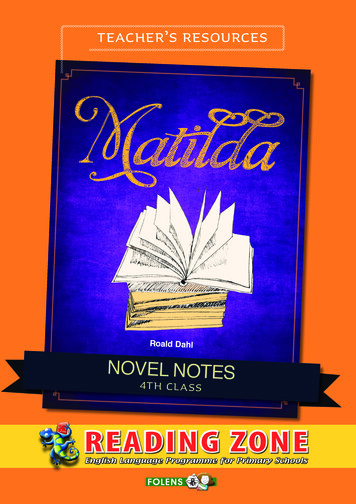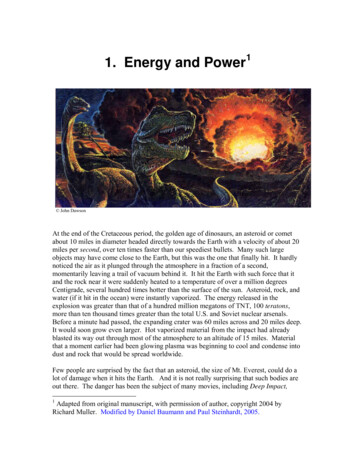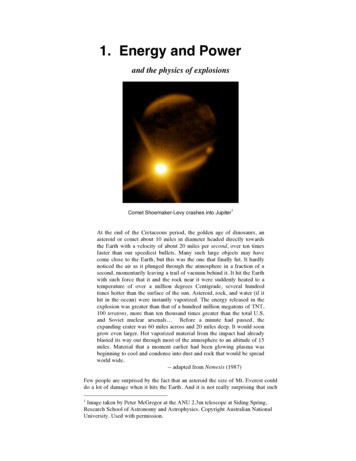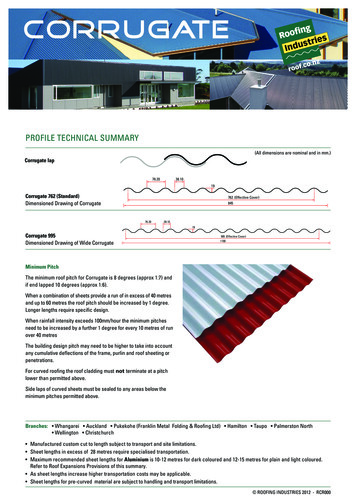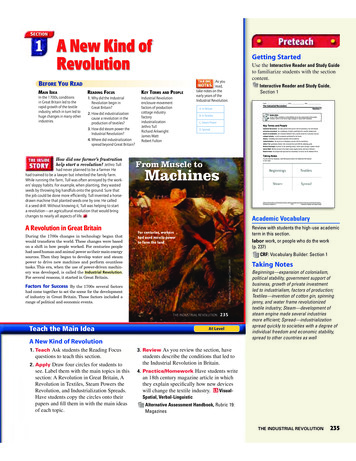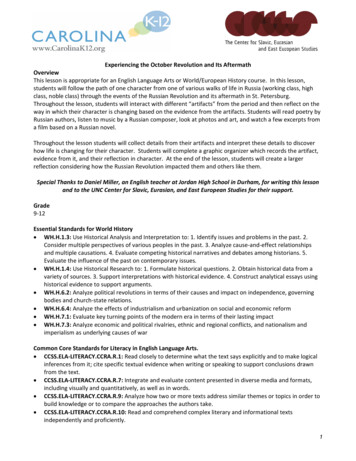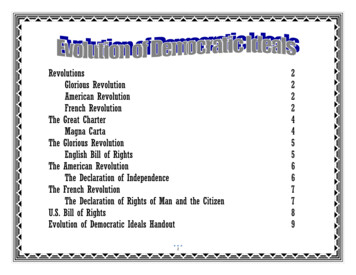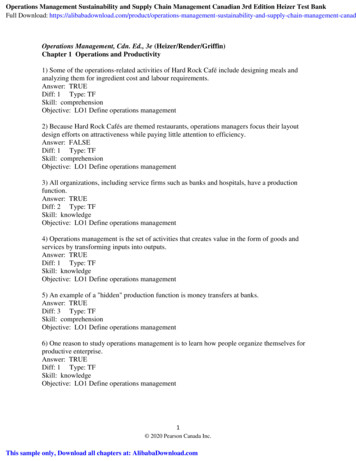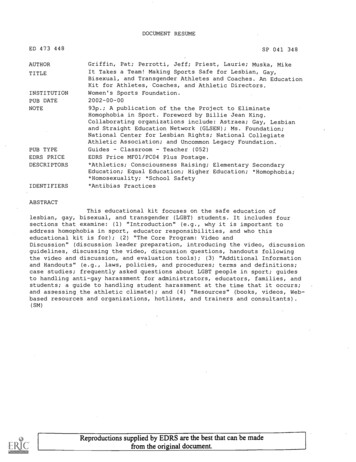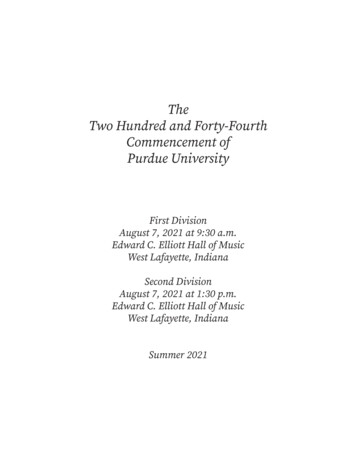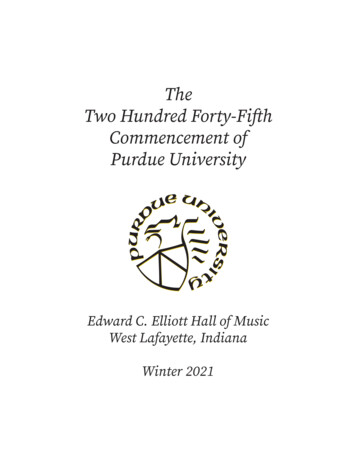
Transcription
Easy Simulations: American Revolution Renay Scott, Published by Scholastic Teaching Resources
Scholastic Inc. grants teachers permission to photocopy the activity sheets from this book for classroom use.No other part of this publication may be reproduced in whole or in part, or stored in a retrieval system, or transmitted inany form or by any means, electronic, mechanical, photocopying, recording, or otherwise, without written permission of the publisher.For information regarding permission, write to Scholastic Inc., 557 Broadway, New York, NY 10012.Editors: Tim Bailey, Maria L. ChangCover design by Jason RobinsonCover illustration by Doug KnutsonInterior design by Holly GrundonInterior illustrations byISBN-13: 978-0-439-52221-2ISBN-10: 0-439-52221-8Copyright 2007 by Renay ScottAll rights reserved.Printed in the U.S.A.1 2 3 4 5 6 7 8 9 10 4015 14 13 12 11 10 09 08 07Easy Simulations: American Revolution Renay Scott, Published by Scholastic Teaching Resources
ContentsIntroduction. . . . . . . . . . . . . . . . . . . . . . . . . . . . . . . . . . 5Setting the Scene: The American Revolution. . . . . . . . . . 7Before You Start: Organizingand Managing the Simulation. . . . . . . . . . . . . . . . . . . . . 9Episode 1: Before the Storm. . . . . . . . . . . . . . . . . . . . . 24Episode 2: The Shot Heard Round the World . . . . . . . 29Episode 3: Declaring Independence. . . . . . . . . . . . . . . 44Episode 4: Winter at Valley Forge . . . . . . . . . . . . . . . . 50Episode 5: Yorktown. . . . . . . . . . . . . . . . . . . . . . . . . . 56Resources. . . . . . . . . . . . . . . . . . . . . . . . . . . . . . . . . . . 62Easy Simulations: American Revolution Renay Scott, Published by Scholastic Teaching Resources
Easy Simulations: American Revolution Renay Scott, Published by Scholastic Teaching Resources
IntroductionWelcome to Easy Simulations: American Revolution. Using simulations inthe classroom is one of the most powerful teaching methods you can choose.Students learn most when they see a purpose to an activity, are engaged inthe learning process, and are having fun. Children love to role-play, andthey do it naturally. How often have you overheard them say somethinglike, “O.K., you be the bad guy, and I’ll be the good guy”? Why not tap intostudents’ imaginations and creativity and teach them by engaging them in asimulation?What Is a Simulation?Asimulation is a teacher-directed, student-driven activity that provides lifelike problemsolving experiences through role-playing or reenacting. Simulations use an incredible rangeof powerful teaching strategies. Students will acquire a richness and depth of understandingof history impossible to gain through the use of any textbook. They will take responsibilityfor their own learning, discover that they must work cooperatively with their team in order tosucceed, and learn that they must apply skills in logic to solve the problems that they encounter.You will find that this simulation addresses a variety of academic content areas and fullyintegrates them into this social studies activity. In addition, simulations motivate all of yourstudents to participate because what they’re required to do will be fully supported by theirteammates and you.History Comes AliveThe American Revolution simulation is designed to teach students about this importantperiod of history by inviting them to relive that event. Over the course of five days, theywill recreate some of the experiences of the people who were beginning a new nation. By takingthe perspective of a historical character living through the event, students will begin to see thathistory is so much more than just names, dates, and places, but rather, real experiences of peoplelike themselves.Easy Simulations: American Revolution Renay Scott, Published by Scholastic Teaching Resources
Briefly, students will find out what it was liketo live as a colonist in the late 1700s in Lexington,Massachusetts. After choosing a profession, theywill discover that life in colonial Lexington isabout to change dramatically. In the War forIndependence, students will have to choosewhether to stay loyal to England’s King George IIIor rebel against him and start their own country.They will live through some of the most importantevents in the American Revolution and finally,participate in the British surrender at Yorktown.Throughout all these events, students will keepa diary of their experiences and use their problemsolving skills to deal with challenges they willencounter. At the end of the simulation, they will write a final diary entry, describing what theyhave learned during the simulation. You can use this diary as an ongoing assessment tool todetermine what students are learning.Everything You NeedThis book provides an easy-to-use guide forrunning this five-day simulation—everythingyou need to create an educational experiencethat your students will talk about for a very longtime. You will find background information forboth yourself and your students that describes thehistory and significance of the American Revolution.You’ll also find authentic accounts—letters andjournals—of people who were alive during thispivotal time in history, as well as maps, charts,illustrations, and reproducible student journal pages.Engaging extension activities can be used during thesimulation or as a supplement to your own AmericanRevolution unit. Before you begin thesimulation, be certain to readthrough the entire book so youcan familiarize yourself with howa simulation works and prepareany materials that you mayneed. Feel free to supplementwith photos, illustrations, video,music, and any other details thatwill enhance the experience foryou and your students. Enjoy!Easy Simulations: American Revolution Renay Scott, Published by Scholastic Teaching Resources
Setting the Scene:T he American RevolutionBy the mid-1700s, life in the American colonies had settled into a comfortablerhythm. For the most part, the colonists had been allowed to govern themselves.Britain’s attention was elsewhere—it had been engaged in a war with France over vastterritories in America for several years. But with the end of the French and Indian Warin 1763, things were about to change for the colonists. The war that had gained Britainmuch of the land once held by France proved to be quite costly. To help pay its debt fromthe war, Britain passed a series of acts (laws) that taxed the colonists.In 1764, the British Parliament passed the Revenue Act, knownas the Sugar Act in the colonies. The law placed a tax on molassesentering the colonies. The following year, Britain passedthe Quartering Act, requiring colonists to help payfor housing the British soldiers stationedin the colonies. Around the same time, thecontroversial Stamp Act was also passed.This law placed a tax on marriage licenses,newspapers, and 47 other documents. These taxesangered the colonists, who protested that they didn’thave a say in the law. They had no vote in the BritishParliament and complained that this was “taxation without representation.” They startedforming secret groups called the “Sons of Liberty,” who met to find a way to oppose theStamp Act. Colonists began to take sides. Those who agreed with Britain were calledLoyalists, and those who opposed were called Patriots.Easy Simulations: American Revolution Renay Scott, Published by Scholastic Teaching Resources
The American Revolution (continued)Disappointed over the colonists’ response to the earlier laws, Charles Townshend tookover the job of raising money for Britain. He enacted another series of laws called theTownshend Acts in 1767. These laws included new taxes on lead, paint, paper, glass,and tea imported to the colonies. In protest, the colonists boycotted (refused to buy)these goods. In addition, they started attacking public officials like the governor and taxcollectors. Britain responded by sending troops to keep order in 1768.The colonists resented the growing number of British troops. Tension was rising. InMarch 1770, a group of colonists gathered near a customs house that British soldierswere guarding. The colonists mocked the troops and began throwing snowballs at them.Someone yelled, “Fire!” and shots rang out. Even though the British soldiers were underorders not to shoot, they did, and five colonists died. This event became known as theBoston Massacre.Hostility between Britain and the colonists escalated over the next three years. In 1773,a group of Patriots who were tired of the tax on tea decided to make a statement. Late onthe night of December 16th, the Patriots, disguised as Indians, crept toward the BostonHarbor. They boarded three ships loaded with tea from Britain and tossed more than 300chests of tea into the Boston Harbor. The Boston Tea Party, as it became known, greatlyangered England’s King George III, and he dispatched even more troops to the coloniesin 1774. The colonists persisted with their boycotts and written protests in newspapers.As a new year dawns, relations between England and the colonies are reaching thebreaking point. Easy Simulations: American Revolution Renay Scott, Published by Scholastic Teaching Resources
Before You StartOrganizing and Managing the SimulationBefore students embark on their exciting five-day experience, you’ll need to set the stage forthe simulation. First, make photocopies of the reproducible pages at the end of this section:4 Life in the Colonies (pages 16–17)4 Choose a Role (page 18)4 A Colonist’s Diary and journal page (pages 19–20)4 Rubrics (pages 21–22)4 Simulation Spinner (page 23)Explain to students that they will be recreating history, using the simulation and theirimaginations to learn what it was like to be an American colonist during the Revolutionary War.They will be taking on the roles of different colonists in that time period and making the samedecisions that those colonists made.Distribute copies of “Life in the Colonies” to students. You might also want to reproduce thepage on a transparency to display on the overhead projector. Together, read the selection tobuild students’ background knowledge about the time period they’re about to live through. Thendivide the class into three groups. These three groups will represent the divisions that existedamong the colonists in 1774. One group will be the Patriots, another the Loyalists, and the lastgroup will represent the Undecided Citizens.Choosing a RoleAfter you have divided the class into three groups, distribute the “Choose a Role” handout, whichdescribes the various roles students can play. Invite students to select a role from the handout,explaining that these “roles” are typical occupations in the New England colonies. Each rolecomes with its own set of special skills, with strengths and weaknesses indicated by a numberranging from 1 to 5. These numbers are called Attributes. The higher the attribute number, themore able the character. (See Attributes, next page.) The Morale number indicates how confidenta character is in the choice he or she has made to support the king or rebel against Britain.Morale can change throughout the simulation.Encourage students within each group to choose a variety of roles to make the simulationmore interesting. After students have chosen a role to play in the simulation, they will get achance to develop their characters more fully and learn what it was like to be a colonist living inLexington in 1774. They will do this in Episode 1 (page 24).Easy Simulations: American Revolution Renay Scott, Published by Scholastic Teaching Resources
AttributesAttributes are the numbers that make each role unique. The attributes are Military Expertise,Common Sense, Stamina, Negotiating Skills, Loyalty, and Morale. Throughout the simulation,attribute numbers will be used during “skill spins” to resolve various situations that the groupswill encounter. Players spin the spinner (page 23) and compare the number they spun to theirattribute number to decide whether their attempt at solving a problem is successful or not. Forexample, say a student’s character is trying to forage for food during the harsh winter at ValleyForge. If the number he spins is equal to or lower than his Common Sense number, then he hassucceeded in finding food.An attribute check can be made only once per person per situation. In other words, if astudent fails in his Common Sense skill spin then that person cannot attempt to forage again.Someone else would have to try his or her luck by making another Common Sense skill spin.Below is a description of the various Attributes:Military Expertise: How skilled a character is at being a soldier. Some men hadformal training in the army during the French and Indian War as colonial militia(minutemen), and some had no training at all.Common Sense: A person’s wisdom and ability to understand and reason. This canbe very important in figuring out how to react to different situations and foreseeingproblems.Stamina: How much physical and mental endurance a character has. For instance, itwould be used to determine how well a colonist can withstand hunger, fatigue, or cold.Negotiating Skills: How well a character can reason with or influence other people.Loyalty: A person’s sense of commitment to a particular cause or way of thinking.Morale: How strongly a character feels about his or her choice to be a Patriot orLoyalist. A high number indicates a colonist who strongly believes that she is rightin her decision to either support or rebel against the king. A low number indicatesa person who is second-guessing his decision and might decide to go over to theother side. Of all the attributes, this is the only number that changes throughout thesimulation. The Morale number is set apart from the other attributes on the student’scharacter sheet. At times students will be called upon to spin for their Morale. Ifthey spin their Morale number or lower, then they continue with the side that theyare currently on. But if they spin a higher number, then they must spin their Loyaltyattribute number or lower to stay on the same side.10Easy Simulations: American Revolution Renay Scott, Published by Scholastic Teaching Resources
Keeping a JournalAfter students have chosen their roles, distributecopies of “A Colonist’s Diary” pages—one copy of thecover page and six copies of the blank Dear Diarypage. Explain to students that they will be recordingtheir experiences during the simulation in theirdiaries on a daily basis. To give the diaries a morerealistic look, have students use a sheet of 12-by18-inch brown construction paper or a large brownpaper grocery bag for the cover. Demonstrate how to“sew” the journal pages inside the cover page using ahole punch and yarn, as shown below.On the cover page, have students fill ininformation about the character they’ve chosen—their assumed name, role, allegiance (i.e., Loyalist,Patriot, Undecided Citizen), and attribute numbers.When writing in their diary pages, have studentsAstudent’s diary often yieldsrich insights into the student’sunderstanding of historicalevents and how they impactedordinary citizens’ lives. Use thesediaries as your primary tool forassessing students’ participationand evaluating how well theyunderstand the simulation’scontent. (See Assessing andEvaluating, page 15.)Sandra BarkerPete / Farmer434134Easy Simulations: American Revolution Renay Scott, Published by Scholastic Teaching Resources11
Date: April 19, 1775Dear Diary,Today I saw a friend of mine shot deadby the British! It happened in the villagegreen this morning. We had heard thatthe British were coming to Lexington toarrest some of the Patriot leaders andcapture war supplies hidden in town. Butrecord the date of the simulation, not the actualdate. For example, use April 19, 1775, ratherthan November 6, 2007. Students should recordthe events in that day’s episode. Encourage themto write their diary entry “in character,” as ifthe events were really happening to them. Thisactivity gives students the opportunity to takeon another person’s perspective and experiencehistory as such.when the soldiers got here they foundPatriot minutemen waiting for them!There was some shouting and then all of asudden they were shooting at each other!Conducting the SimulationThis simulation is divided into five episodes—onefor each day of the school week—each re-creatingthe shooting to stop. That is when I sawkey events in the American Revolution. Considermy friend lying on the ground. He hadstarting the simulation on a Monday so that it willbeen shot! I have always been undecidedwhether to stay loyal to the king orrun its course by Friday. Complete all preparatorysupport the Patriots but now I think Iwork (e.g., building background knowledge,might join the Patriots!choosing a character, etc.) during the prior week.PeteEach episode should take about 50–70 minutes,depending on your class size.The simulation opens with students in the townof Lexington, Massachusetts, in 1774, just before the first battles of the American Revolution.Students will start by conducting research about the life and culture of the colonies duringthe 1770s. Once cast into character with an understanding of colonial society, students willexperience the Battles of Lexington and Concord, the proclamation of independence by colonists,winter at Valley Forge, and the surrender at Yorktown. By the end of the simulation, students willhave “participated” in events that happened from 1774 to 1781.In between each event, students will learn more about life in colonial America, the course ofthe War for Independence, and the various groups of people affected by the war. The simulationincludes the following five episodes:I hid behind a stone wall and waited forEpisode 1: Before the StormEpisode 2: The Shot Heard Round the WorldEpisode 3: Declaring IndependenceEpisode 4: Winter at Valley ForgeEpisode 5: Yorktown12Easy Simulations: American Revolution Renay Scott, Published by Scholastic Teaching Resources
Each episode starts with background information, which puts the event students are about tosimulate in context. The episode also features a scenario and an activity. The scenarios presentproblem-solving situations that re-create some of the events during the Revolution. The activitiesare research opportunities designed to enhance students’ understanding of life in America at thistime in history. These activities often require students to conduct research on the Internet. In theResources section at the back of the book, we provide Web sites that have been researched, arehistorically accurate, and are student-friendly. (*NOTE: Always check the links PRIOR to lettingstudents access them on the Internet as the content of Web sites tends to change over time.) Youmight choose to skip the activities and have students conduct all their research at the beginningof the unit before starting the simulation. Building background knowledge before engaging inthe simulation will enrich the experience for students. Activities can be completed in class or ashomework.A Sample ScenarioThe scenario presented in each episode is where students actually get to participate in ahistorical event. Let’s walk through the scenario in Episode 2 to see how a simulation scenariois typically run:After you have read or paraphrased the background for students, have each group cometogether in separate areas of the classroom. Describe the scene in which the British soldiers aremarching toward the Village Green in Lexington. Students who are playing Patriots are standingin the green facing the advancing Redcoats. Loyalists are waiting to see how they can help theBritish. Undecided Citizens are watching from windows and behind stone walls to see what willhappen. Each group will have a set of options to choose from as events occur. The Patriots willmake their choice first. Read the following description to students playing Patriots:Patriots, you and about 75 other minutemen have gathered on the Village Greenoutside Buckman Tavern. Coming toward you are several hundred Redcoats inbright red uniforms, marching in perfect order. Your commander, Captain JohnParker, shouts to you: “Stand your ground; don’t fire unless fired upon, but if theymean to have war, let it begin here.” As you watch, a British officer comes forwardand shouts, “Disperse, ye rebels, disperse!”Now Patriots, you need to decide what to do as the British soldiers march towardyou. Pick from the following choices:1. Load your weapon and fire at the approaching soldiers.2. Get your weapon ready and prepare to fire.3. Duck into the tavern door to get cover in case they start shooting.Easy Simulations: American Revolution Renay Scott, Published by Scholastic Teaching Resources13
Teacher:O.K., has everyone had enough time to decide what they want to do?Kayla:I am going to prepare to fire.Teacher:Alright. (Noting on a piece of paper that Kayla is choosing #2) Bob?Bob:Yeah, I’ll do that too.Teacher:O.K. (Makes a note of that) Juan?Juan:That sounds good. I’ll do that too.Jennifer:I want to do that too.Teacher: Alright, both Juan and Jennifer want to get their weapons ready. Mandy, you arelast. What did you decide to do?Mandy: I’m not going to take any chances. I’m going to blast the Redcoats!Teacher: O.K. (Noting all of the students’ choices) Now, let’s see what happened because ofyour decisions. Let’s start with Mandy. Mandy, you need to spin your MilitaryExpertise number or lower in order to shoot one of the approaching Redcoats.Mandy: (groaning) I’m a lawyer. I need to spin a 2 or less!Teacher: Too late now. Go ahead and spin. (Mandy spins a 5 and her Military Expertise isa 2) As you fire at the approaching Redcoats, Captain Parker turns and yells atyou, “What are you doing?” Now everyone else, spin on your Common Sense tosee if you stand and fight or retreat into town as the British soldiers begin firinginto your group.This is how the scenarios will typically run, with role-playing students dealing with thesituations that confront them, and you, the teacher, acting as coordinator. You present thesituation in the scenario to students and then give them time to make their decisions. Do notreveal the outcome of each student’s decision until everyone in the group has responded; onlythen do you respond to each person as the rest of the class observes and resolves the outcome ofhis or her choices as scripted in the scenario.At the end of each scenario, students’ Morale can be affected by how students handled thesituation. For example, at the end of the above scenario, the Patriots win the Battles of Lexingtonand Concord and get to raise their Morale by 1, while the Loyalists subtract 1 from their Morale.The Undecided Citizens don’t adjust their Morale. Next, everyone makes a Morale spin. A studentmust spin his Morale or lower to stay loyal to his side. If a student spins higher than her Morale,then she must make a Loyalty check and spin her Loyalty number or lower. If she spins higherthan her Loyalty number, then she must move to the other side.14Easy Simulations: American Revolution Renay Scott, Published by Scholastic Teaching Resources
For example, Gina is a Loyalist with a Morale of 4. At the end of the scenario her Morale hasbeen lowered to 3 because the Patriots have won the Battles of Lexington and Concord. Sheneeds to spin a 3 or less to remain steadfast in her support of the king. Instead she spins a 5and must now make a Loyalty spin. She has a Loyalty of 3 but she spins another 5. Now she isno longer a Loyalist but has moved to the Patriots. If she had made a Loyalty spin of 3 or lowerthen she would have remained a Loyalist. If any Undecided Citizen spins higher than her Loyaltynumber, then she must commit herself to either the Loyalists or the Patriots—it is her choice.Assessing and EvaluatingThroughout the unit students should be assessed on their historical understanding. This can bedone through assessing the authenticity and historical accuracy of how they play their characterand the diary entries they’ve written throughout this simulation.Use both rubrics on page 21 to give each student a daily score, based on the student’s diaryentries and your observations. Each rubric is scored on a scale of 1 to 5, with 1 being the lowestpossible score and 5 the highest. Add the two scores to generate a number from 2 to 10. Convertthis total score to a percentage score by multiplying it by 10. You can award scores such as 4.5if you feel a student was at least a 4 but not quite a 5. This daily percentage score can then beaveraged over the week to generate a final grade for the simulation.Student LogTeacher ObservationsScorePercentageMonday3 4x 1070%Tuesday4 4x 1080%Wednesday3.5 5x 1085%Thursday2.5 4x 1065%4 5x 1090%FridayAverage forthe week78%For a more in-depth assessment of the students’ diaries, use the rubric on page 21.Easy Simulations: American Revolution Renay Scott, Published by Scholastic Teaching Resources15
Student PageLife in the ColoniesThe 13Coloniesf you lived in the coloniesMaine(part ofNew HampshireMassachusetts)during the 1700s, whatwould you have seen? Forone thing, you’d have seenMassachusettspeople from many differentNew Yorkcountries. You might thinkRhode Islandcolonists came only fromConnecticutPennsylvaniaBritain, but several were fromNew JerseyGermany, the Netherlands,DelawareIreland, and Scotland. ThereMarylandVirginiawere also black slaves and,of course, Native Americans.AtlanticNorthImmigrants settled all alongCarolinaOceanthe eastern coast of the “NewSouthWorld.” The populationCarolinadoubled every 25 years.GeorgiaThe largest colony wasVirginia, with New York andMassachusetts close behind.People lived in cities,villages, and farms. Most colonists worked as farmers. Others made a living as carpenters andblacksmiths, while some learned special skills like shoemaking or crafting silver. Wealthymerchants sold goods shipped in from Britain and the West Indies.When not helping on the farm or in the family business, children would attend school.School began at 9:00 a.m. and ended at 5:00 p.m. Often classrooms contained children ofI161700sEasy Simulations: American Revolution Renay Scott, Published by Scholastic Teaching Resources
Life in the Colonies (continued)different ages. One-room schoolhouses werequite common. Books and paper were in shortsupply, so children had to memorize poems,stories, and verses. The New England Primer wasthe most popular textbook. In their free time,children enjoyed playing a variety of games.One popular game was “rolling the hoop.” Inthis game, children would try to roll a woodenhoop toward a goal faster than anyone else.They also played tag, ran races, swam, fished,and played with wooden toys.Entertainment for grown-ups came in theform of music and dance. Many dances werenew to America. Musical theater was alsopopular. People came to hear operas in whichperformers sang the dialogue to tell a story. Hanging out at taverns was another form ofentertainment. Here people told stories and exchanged news.Communication in colonial times was much slower than it is today. News traveled fromeast to west. Newspapers, letters, and stories arrived from Britain via ships, which took abouta month to reach the colonies. Once news arrived in America it spread from town to townthrough word of mouth. Newspapers with articles about events and life in Britain were oftenshared from person to person. News was also discussed in taverns and at church. NativeAmericans and settlers traveling west shared the news with people living in the backwoodsand soldiers at forts. By the time news reached the westernmost edge of the colonies, it couldbe months old.As you can imagine, travel was also slow in colonial times. Transportation was most easilydone by river. Narrow, unpaved paths connected towns and villages. Most people traveledby horse, but the wealthy rode in horse-drawn carriages. It took three days to get fromPhiladelphia to New York City. Today it would take about two hours.How would you have liked living in the 1700s?Easy Simulations: American Revolution Renay Scott, Published by Scholastic Teaching Resources17
Name:Date:Student PageChoose a RoleSelect the role that you would like to play during the American Revolution simulation, then choose aname for your character. Record your choice and your attributes in your ith342334435214Tax 424IndenturedServantBlacksmith – You own your own blacksmith shop.Tax Collector – You have faithfully served the EastYou work long hours, sometimes 10–12 hours aIndia Company as an accountant for years. Recentlyday. You make horseshoes for the local farmers andthe governor has appointed you as the tax collectorfor the British soldiers.for the citizens of the town.Silversmith – Your expertise as a silversmith isLawyer – You have studied law since you were 13well known in Massachusetts. The governor usesunder a well-known lawyer in your town. Recentlyyour silver during his dinner parties. In additionyou decided that you have learned enough and haveto making silverware, you also craft tools, buttons,begun your own practice.watches, and jewelry.Farmer – The farm has been in your family forIndentured Servant – You have been in theyears. Your parents are buried on this land alongcolonies for just over a year now. You came after awith two of your siblings. As the firstborn son, youfarmer paid your way. You now work for the farmer,inherited the farm.planting and harvesting until you have paid backMerchant – Your store trades daily for the goodsyour debt to him. You came to the “New World”brought by sh
integrates them into this social studies activity . In addition, simulations motivate all of your students to participate because what they’re required to do will be fully supported by their teammates and you . History Comes Alive T he American Revolution simu
